Creating an optimised population of Sydney’s newest Eucalypt
To conserve populations of Eucalptyus cryptica, geneticists identified least related plants and designed a new population which maximised genetic diversity.
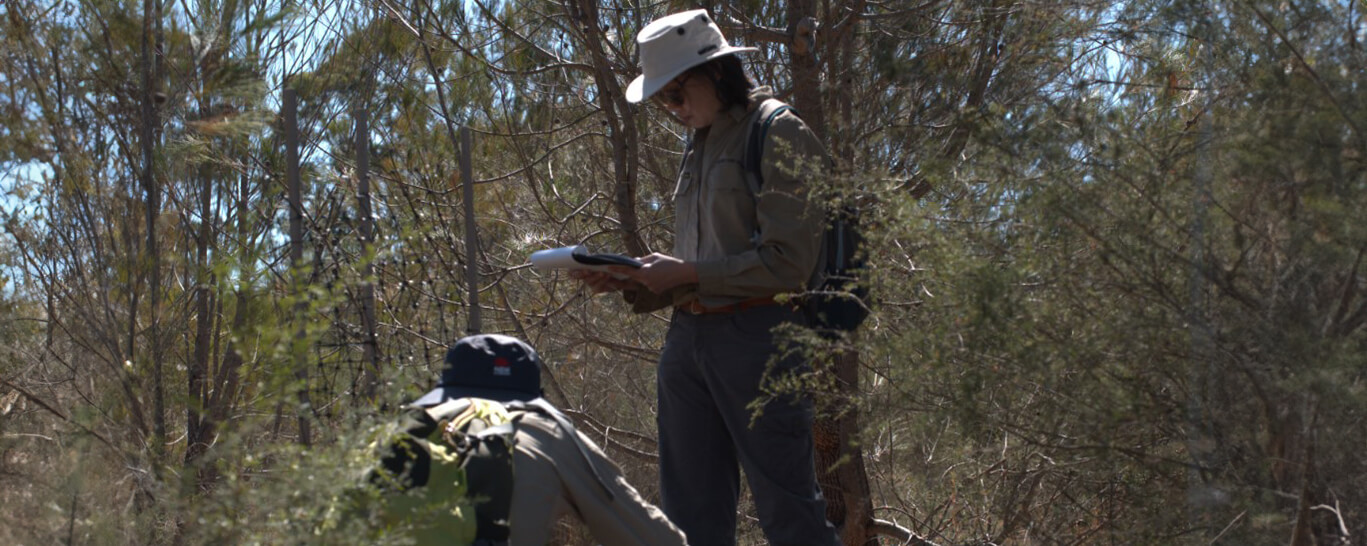
Key findings
- After decades of puzzling taxonomists, genetics was used to support morphological studies and confirm a new species of Eucalypt. The new species received the name Eucalyptus cryptica.
- Eucalyptus cryptica is critically endangered and occurs only in northern Sydney in a cluster of fragmented populations, on private land at risk of development. The populations are threatened by genetic isolation and hybridisation, as well as weeds and changing fire regimes.
- To conserve the populations, geneticists identified least related plants and designed a new population which maximised genetic diversity.
- This new population was planted in southern Sydney in 2020 and 2022. The site is further south of the species’ natural range, as part of a managing climate risk.
- Monitoring has shown excellent establishment but curious differences in growth between plants of the same age. These differences can be investigated with genetics and future population augmentation undertaken to help create a self-sustaining population.
What’s in a name?
Eucalyptus cryptica was first recognised by Steve Douglas and the late Ian Brooker in the 1990s, who termed it Eucalyptus cattaiensis or Eucalyptus sp. “Cattai” based on its occurrence in the catchment of Cattai Creek in north-western Sydney. In 2012, Van Klaphake described it as a species his identification book ‘Eucalypts of the Sydney Region’, after extensive sampling. Despite the 2012 description, there was still uncertainly about Eucalyptus sp. ‘Cattai’ being a distinct species rather than a hybrid. If genetically isolated, Eucalypts will hybridise with other species, rather than inbreed. It was this suspected hybridisation which made the taxonomy, or determination of a new species, so challenging, because the features of E. cryptica were confused. Sometimes the features were reminiscent of Eucalyptus resinifera and other times they were similar to Eucalyptus notabilis. Some of the earliest collections had even been classified as a dwarf form of otherwise common species. Using genetics, the team was able to confirm not only that the then Eucalyptus sp. “Cattai” was indeed a distinct species, but also identify which individual plants were hybrids. A formal description was produced in 2023, which paired genetic data with 17 morphological features, such as habit, bark, buds, flower, and leaf dimensions. The formal epithet became ‘Eucalyptus cryptica’ and was assigned by Steve Douglas. A name was sought in the Dharug language of the Aboriginal country in which the species occurs, but no such name was discovered.
Determining hybrids and unique species is important for conservation planning as it can help plan collection of ‘pure’ specimens as well as collection and propagation of plants with unique genotypes. For Eucalyptus cryptica, genetics was also used to design a translocation with the aim of creating a new viable population to help buffer the species from threats.

Botanical illustrations of morphological features associated with Eucalyptus cryptica. (a, b) Habit of seedling); (c,d) seedling with cotyledon; (e) mallee habit of adult; (f) detail of bark. Illustration: (L. Elkan). Source Wilson et al. (2023)
Ex-situ living collection
Whilst all the taxonomic confusion was being methodically worked through, other conservation actions were simultaneously occurring. To preserve the existing wild genotypes a collection of seeds from across the population extent was made. Some of these collected seeds were grown at the Australian Botanic Garden Mt Annan. It was from the ensuing seedlings that geneticists were able to identify which seedlings were the most genetically unique (i.e., had different allele combinations) and should be used for conservation actions, such as translocation. As new plants are located these can be added to future analysis to determine if they represent new, previously not captured genotypes.
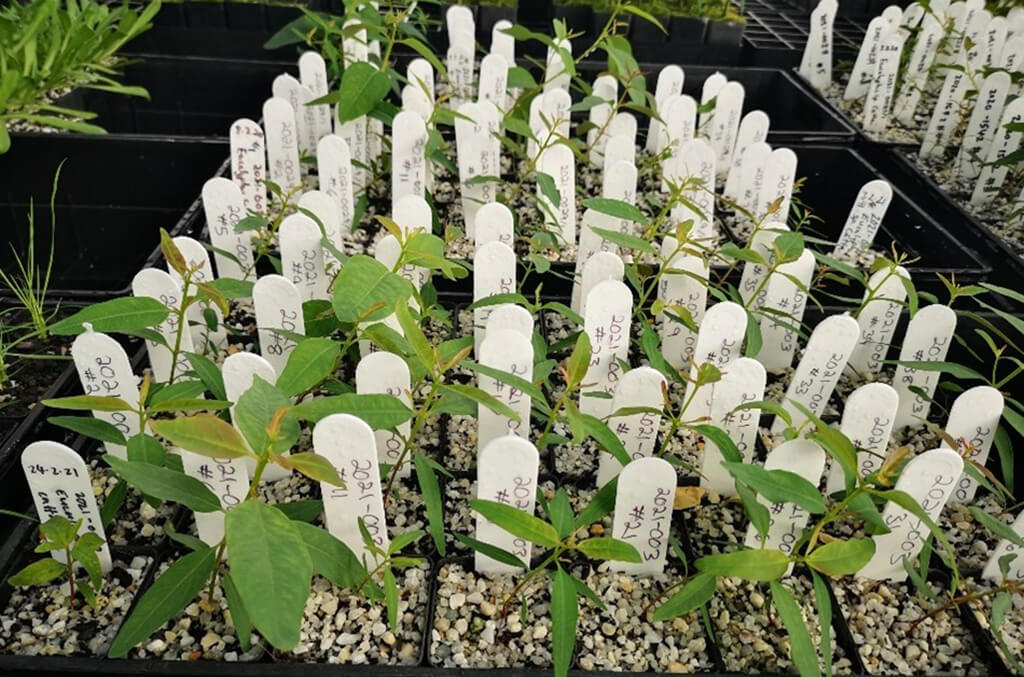
Eucalyptus cryptica seedlings in ex-situ living collection at Australian Botanic Garden Mt Annan. Credit: Dr Samantha Jia-Yee Yap.
Using genetics to inform a new translocated population
Eucalyptus cryptica is known from approximately 600-700 individuals in isolated remnant patches in the Sydney Basin. The decision to create a new population of Eucalyptus cryptica was made because all wild populations occurred on private or soon to be private land and were at risk of development pressures as well as fragmentation, leading to further genetic isolation and hybridisation. Using climate and habitat suitability modelling, a site within a national park in the south of Sydney was selected for the new population.
Planting of the first 60 plants from the seedling collection occurred in 2020 and a second planting of 61 genetically optimised plants occurred in 2022. The plantings were strategically designed in a block format where the least genetically similar plants were planted next one another. This block planting design was implemented to maximise the chances of outcrossing or pollen exchange between least related plants. In the long term this mixing should result in seed with new combinations of alleles and consequently a population with high genetic diversity. High genetic diversity enables a species to have a greater ability to respond to threats such as disease and drought. The block planting design also means that the impact of location can be analysed alongside factors like growth, survival and reproduction
Is planting the end?
Absolutely not. Planting is the beginning of a long-term commitment. We can view the planting as the mid phase of trying to answer many questions about the species, its reproduction, and its relationships with other organisms in the landscape. Creating a new population that will be viable and self-sustaining long term might seem simple in theory, but recreating a functioning system is extremely difficult and at the edge of current translocation science!
An important aspect of the long term commitment is monitoring to track survival, growth and reproduction, as well as identify threats such as disease. Monitoring of the population is conducted regularly by Dr Enhua Lee, Senior Threatened Species Officer with the NSW Government's Saving our Species program and has shown very high survival (93%). Curiously, some plants have grown rapidly, and three years post planning exceed three metres. Whilst others planted at the same time, remain less than 50 cm tall, despite being healthy. Genetics can support these monitoring results through potentially identifying which alleles are unique to the plants with limited growth. Genetics can then advise which plants to use in future out-planting to optimise growth and reproduction, but also to make sure the unique genotypes of these small plants are not lost from the populations. We always remember that genetic diversity is the primary goal of creating a new population. The more diversity the greater the changes a population can tolerate changes to environment or disease, adapt and continue reproducing.
As the plants grow and begin to reproduce the teams at the Botanic Gardens of Sydney and NSW Saving our Species will also collect seed, and from the 1st generation of seedlings (F1 generation) genetics can be used to determine which plants are the dominant parents. This is called the founder effect, where a few males and females produce most the offspring in a population. In the long term if only a few parents remain the dominant contributors of pollen and seed, the genetic diversity of other plants will be lost or “swamped”. It is a complicated challenge with small populations, particularly newly constructed ones! But a challenge the team has the tools to navigate.
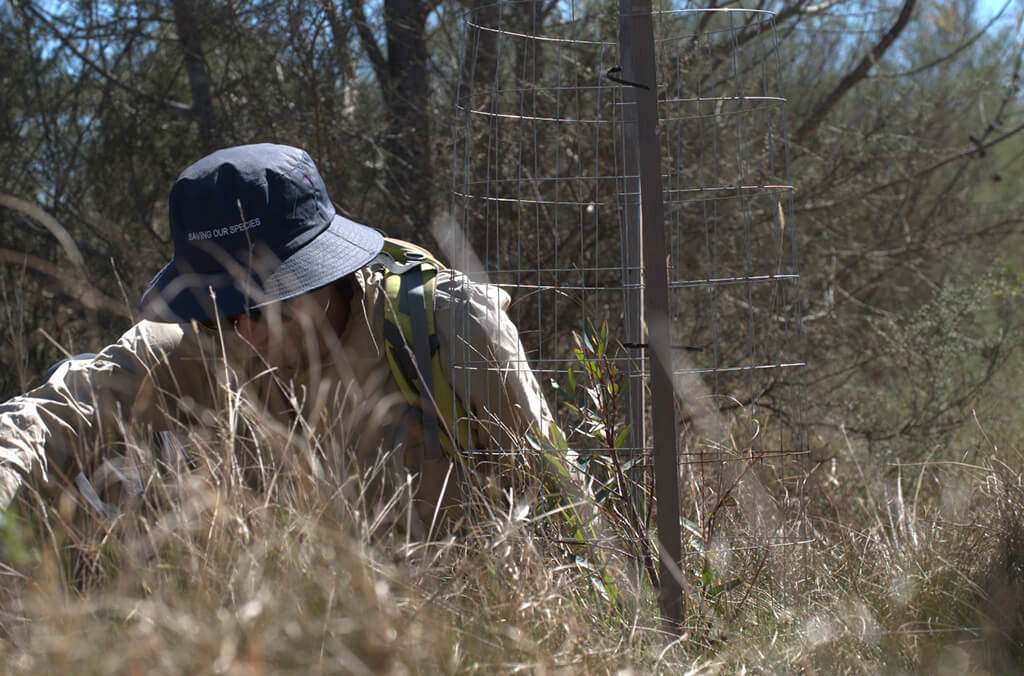
A team effort
What I really enjoyed about this project was working so closely with project partners at the Gardens. Without the genetics and the seed bank teams, I couldn’t get to this point at all. I needed expertise from both groups to understand if a translocation was warranted, produce seedlings, and select the plants with the highest genetic diversity. Only then could I get on with preparing the translocation plan, selecting a translocation site, and implementing the on-ground translocation work. We all got together to translate an on-paper conservation action to a well-executed reality.” Dr Enhua Lee
Conserving species cannot be achieved in isolation. It requires a team with complimentary knowledge, skills, and passion. For Eucalyptus cryptica, first Steve Douglas and Ian Brooker had to notice it was ‘different’. Then they needed to remain tenacious, working with Van Klaphake, in trying to identify if it was a species or a hybrid. The NSW Saving our Species team developed a conservation plan and commissioned genetic research to support identification of a species, as well as coordinated the determination of a new population location, the translocation and monitoring. The Australian Botanic Garden Mt Annan was critical for growing and holding an ex situ collection of the plants and the ReCER geneticists needed to unpick some very confusing hybrid scenarios to optimise a planting. Conservation cannot happen in isolation.
Related stories
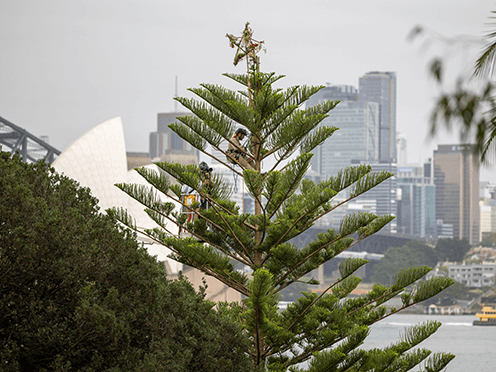
Discover the Royal Botanic Garden Sydney's very own "Christmas trees" - a festive trio of pretty pines from a lineage stretching all the way back to the time of the dinosaurs.

For the team at the Research Centre for Ecosystem Resilience (ReCER), a request from the Blue Mountains Botanic Garden to design a hedge of the towering Nothofagus moorei, or Antarctic beech, sparked a unique collaboration between science and horticulture.
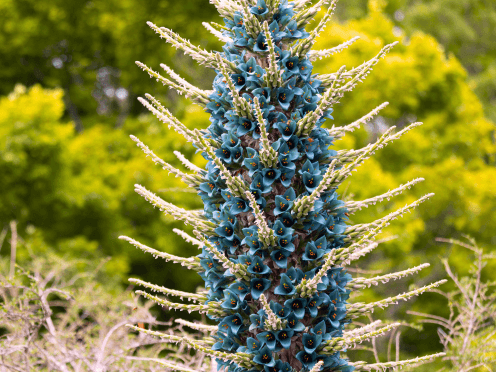
An extraordinary display of rare turquoise blooms are starting to flower at the Blue Mountains Botanic Garden Mount Tomah, with one species blooming for the first time ever.